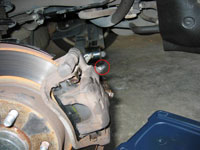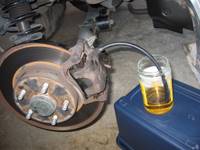|
|
|
How to bleed the brakes
Over time the brake system can take on air as the effectiveness of the brake fluid decreases with age. Air can also enter the system from a leaky brake hose, a bad connection on the brake caliper, during any maintenance when a brake line is removed, or if the fluid reservoir is allowed to run dry.
Air in the line makes the brake pedal feel mushy, and bleeding the brakes is the solution to that embarrassing mushy pedal feel. While we're on the topic, if you're not happy with the factory brake feel even after the system is properly bled, replacing the factory brake lines with more sturdy steel braided lines can greatly increase pedal firmness and brake feel.
tools/Supplies:
- Lug wrench
- 14mm wrench
- Jack
- Clear Jar
- Small hose at least 6" long. Approximate diameter of bleed valve. The tighter fit the better. Auto parts store should have small vacuum hose that will work.
- Fresh jar of brake fluid (do not use a previously opened container since brake fluid takes on moisture over time.
- An assistant or speed bleeders.
| |
|
| |
Did this help you out? Feel free to throw us a bone to help keep housecor's how-to's hosted!
|
| |
|
INSTRUCTIONS:
| 1. |
Place the car on level ground, chuck the rear wheels, and make sure car in park (or in gear if a manual). Make sure parking brake ISN'T on. If you have ABS, remove the ABS fuse.
|
| |
|
| 2. |
Pump the brakes multiple times to release any residual vacuum in the lines.
|
| |
|
| 3. |
Remove the brake fluid reservoir cap and fill the reservoir with fresh brake fluid. Check this level often as you bleed the brakes. Never let it get too low because if it gets empty it introduces air back into the brake system and you have to start all over!
Bleed the brakes in the following order:
1. Passenger rear
2. Driver front
3. Driver rear
4. Passenger front
|
| |
|
| 4. |
Remove the rubber boot on top of the bleeder screw. Attach a hose to the bleed screw and insert the end of the hose into a clear jar that is partially filled with brake fluid.
The bleed screw with the rubber boot still on:

Hose attached to bleed screw:
 |
| |
|
| 5. |
Have your girlfriend press firmly on the brake (you're killing time reading this on the internet so you obviously have one...right?). While the brake is depressed, loosen the bleed screw. If your girlfriend freaks out at this point because the pedal just fell to the floor, throw an empty beer can at her and tell her to quiet down. Or, if you're not much for the single life, you can be the nice guy. "Honey, that it is completely normal. I just loosened the bleeder screw which allows the brake pressure to escape...oh, and I sure like those new strappy shoes of yours." Totally your call on this one.
Anyway, back on topic. When you loosen the bleed screw with the brake depressed, you will see brake fluid flow through the hose and into the jar. Watch the tip of the hose for air bubbles - this is a sign that air is in the system. When the flow of fluid stops, tighten the bleed screw and tell your girlfriend (assuming she's still there) to release the brake. Repeat this process (press brake, loosen bleeder, check for bubbles, close bleeder, release brake) until there are no air bubbles released, only fluid.
If you mouthed off above and lost your assistant, don't worry, this step can also be done alone if you buy a set of speed bleeders. |
| |
|
| 6. |
Check the brake fluid level in the reservoir and top off as needed. Take care not to overfill or spill because brake fluid is very hard on paint. As mentioned above, never let the reservoir get empty or it will introduce air into the system and you'll have to start over. And let's be honest, this job is barely enough fun to do once. |
| |
|
| 7. |
Repeat steps 4 -6 at each wheel in the order outlined above. For the front brakes, if you're feeling lazy you can get away with not removing the wheels at all by turning the tires toward the brake you want to work on. It takes a skinny arm or a strange angle to get a wrench on the bleed screw, but it can be done.
A lazy man bleeding the front brake:
 |
| |
|
| 8. |
When complete, do yourself a favor and double check that every bleed screw is tight. Remember, a loose bleed screw means no brake pressure and brake fluid spraying everywhere like a garden hose. And hey, that's no fun. Well, unless you're the lucky onlooker.
Seriously though, test the brakes on a flat surface before running out and terrorizing the neighborhood. |
| |
|
|
|
|
|
| |
Copyright
© 2003-2009. All rights reserved.
Instructions are for entertainment purposes only. Perform at your
own risk.
This site is in no way affiliated with Nissan North America, Inc.
Nissan, the Nissan Brand Symbol, "SHIFT_" tagline, and
Nissan Model Names are trademarks of Nissan North America, Inc.
|
|
